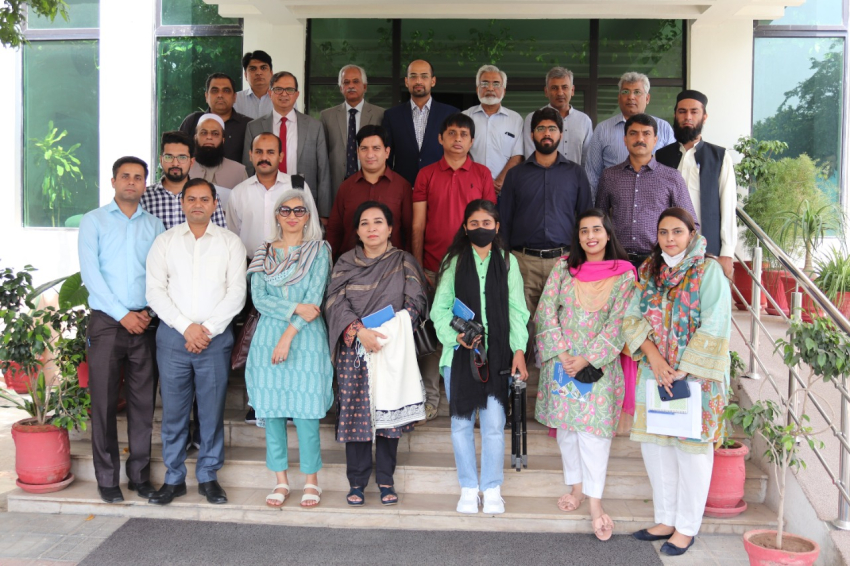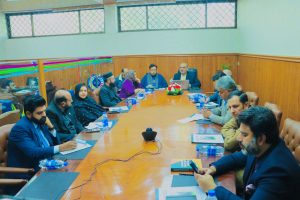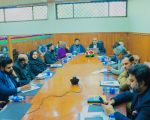ISLAMABAD/ LAHORE – Groundwater recharge well is a cost-effective nature-based solution to revive aquifers and mitigate the risk of urban flooding through the most modern technology available at the local level, experts say.
They were speaking at a media fellowship on Harvesting Rainwater for Urban Flood Management, organised by the Institute of Urbanism, International Water Management Institute (IWMI), and Pakistan Council for Research on Water Resources (PCRWR) and Heinrich-Böll-Stiftung (HBS) on Wednesday.
This fellowship is comprised of field visits to various rainwater harvesting sites in the federal capital and Lahore.
Addressing the media, Chairman, Pakistan Council of Research in Water Resources (PCRWR), Dr Muhammad Ashraf said that the water crisis was a serious issue for Pakistan when it comes to the major metropolitan cities such as Lahore, Islamabad, and Karachi.
“The groundwater recharge solutions are the need of the country. Especially in the prevailing floods that have occurred in an unprecedented fashion,” said Dr Ashraf.
He also said that Pakistan was facing environmental degradation, as in one season the country was facing dryness with less rainfall and after a few months there were floods.
Dr Ashraf further said, “We have to increase water storage at every level and need to develop large, medium, and small dams, where possible.”
Rainwater storage solutions such as artificial lakes in housing societies or artificial groundwater recharge wells can help recharge the groundwater, he added.
He also informed that the Capital Development Authority (CDA) was establishing 100 recharge wells and 20 monitoring stations from its own resources in the federal capital and that 50 recharge wells have already been established.
Dr Mohsin Hafeez, Country Representative – Pakistan and Regional Representative – Central Asia, IWMI, said that the latest IPCC report has highlighted a surge in heatwaves and heavy precipitation in South Asia due to human-induced activities, and both phenomena have occurred this year in Pakistan.
According to him, “It was the worst flood due to riverine and hill torrents flood, which was exacerbated by ill-planned housing societies, construction on riverbeds, and encroachments on water flows.
The Country Representative – Pakistan & Regional Representative – Central Asia, @IWMI_, @drmohsinhafeez briefs the media regarding the artificial groundwater recharge site developed by #IWMIPakistan & #PCRWR with funding from @WaterAidpk @int_urb @BoellStiftung pic.twitter.com/EHzs5r6hVd
— IWMI Pakistan (@IWMI_Pakistan) September 13, 2022
Dr Hafeez further added, “Climate change is having a major impact on water resources, as there been drought for nine months and rainfall for three months in Pakistan. Unfortunately, we have the insufficient infrastructure, as no major dams have been constructed in the past 50 years.”
He mentioned that the water recharge level in Islamabad was 130-150 mm in 1990 which had remained the same in 2021 but the rate of urbanization has substantially increased.
While highlighting the contribution of artificial groundwater recharge well towards groundwater replenishment at the Kachnar Park site, he said, “Up to 1.9 million gallons of water has been added to the aquifer against the rainfall of 589 mm from May – September 2022 alone. Furthermore, a rise in the water table of 4.8 meters has been recorded.”
Sardar Khan Zimri, Deputy Director General, CDA said that rooftop rainwater harvesting sites have been included in the bylaws for the construction of new houses to harvest rainwater at the local level. He told that 50 recharge wells out of 100 have been completed in the federal capital. The CDA is also proposing legislation on recharge wells for new housing societies so that groundwater recharge is ensured in Islamabad.
The media persons also visited the artificial groundwater recharge site jointly developed by IWMI Pakistan and PCRWR. According to Dr Mohsin Hafeez, Country Representative – Pakistan and Regional Representative – Central Asia, IWMI, “This artificial groundwater recharge site has been equipped with state-of-the-art technology, such as water gauge along with automatic data drivers after undergoing a comprehensive study on hydrological modelling of Islamabad.”
On the second day of the media visit, journalists visited various rainwater harvesting underground tanks in Lahore that were state-of-the-art facilities by WASA to store rainwater to prevent urban flooding in the vulnerable areas of Lahore. The water stored in the underground water tanks was later used for watering greenbelt plantations by Parks and Horticulture Authority (PHA). The first site at Bagh-e-Jinnah, Lawrence Road has the capacity to store 1.4 million gallons, with a catchment area of 30 acres and a ponding area of three acres. It was established at the cost of Rs.140 million.
There were two more underground water tanks currently under construction at Sheranwala Gate and Alhamra Arts Council.
The participating journalists were sensitized to the significance of groundwater and the need to use this precious resource sustainably.
Media tours
The media persons also visited the sites of recharge wells installed at PCRWR and Kachnar Park.
The IWMI Country Director told the media that I-8 Kachnar Park recharges well possessed the most modern technology which was implemented after hydrological modelling of Islamabad in which seven potential sites for groundwater recharge were identified.
#Eco_Journalists field visit of Bagh e Jinnah Underground Water Well, #Lahore. This water well, not only reduces water logging on adjacent roads but also serves as source of horticulture water need.@BoellStiftung @IWMI_Pakistan @CDAthecapital @PCRWR3 pic.twitter.com/LYGPsVaGQv
— Institute of Urbanism (@int_urb) September 14, 2022
A PCRWR official briefed the journalists that Kachnar Park recharge well as the only site fully instrumented where a water gauge was installed along with automatic data drivers that monitor water inflow and temperature shift.
He informed that from May to September 78mm of rainfall was recorded in the capital and 1.9 million gallons of rainwater was conserved on this site.
During the second day’s visit, the media delegation visited various rainwater harvesting sites in Lahore that were the first of its kind facilities to store rainwater causing flooding on the thoroughfares of Lahore that were later used for watering greenbelt plantations across the city.
The first site was at Bagh-e-Jinnah along Lawrence Road where a 1.4 million gallons capacity underground water storage capacity was established at a cost of Rs140 million. The site comprised a catchment area of 30 acres and a ponding area of three acres.
#Eco_Journalists field visit of Bagh e Jinnah Underground Water Well, #Lahore. This water well, not only reduces water logging on adjacent roads but also serves as source of horticulture water need.@BoellStiftung @IWMI_Pakistan @CDAthecapital @PCRWR3 pic.twitter.com/LYGPsVaGQv
— Institute of Urbanism (@int_urb) September 14, 2022
The Water and Sanitation Agency (WASA) Lahore developed under the vision that helped end the stagnation of water in this area during 100mm rainfall.
The water tank had two water pumps of six cusecs to pump water to the other site in case of above 100mm rainfall and storage capacity reaching its full volume.
There were also two more underground water tanks underway at Sheranwala Gate and Alhamra Arts Council whereas the latter was near completion.
#Eco_Journalists visited Alhamra Underground #Water Well in #Lahore. Water level sensing cones were of great interest at this site. The cones detect rain water level from roads & display in a live dashboard to improve the response & help in data collection. @BoellStiftung pic.twitter.com/pGG9HU4nxc
— Institute of Urbanism (@int_urb) September 14, 2022
The underground water tanks had huge social benefits including flood-free routes and connectivity during heavy rains and mitigated the risk of urban flooding whereas it gave an additional source of water to increase green cover in the city.













